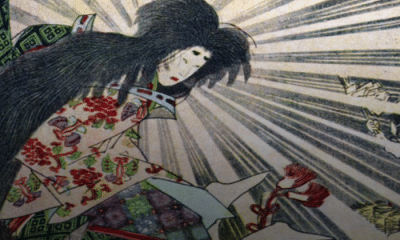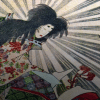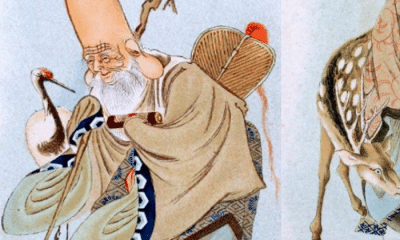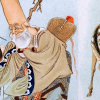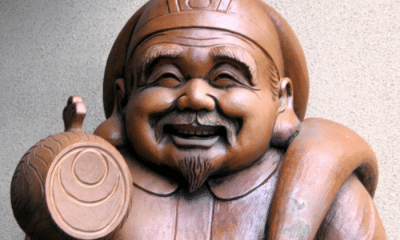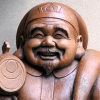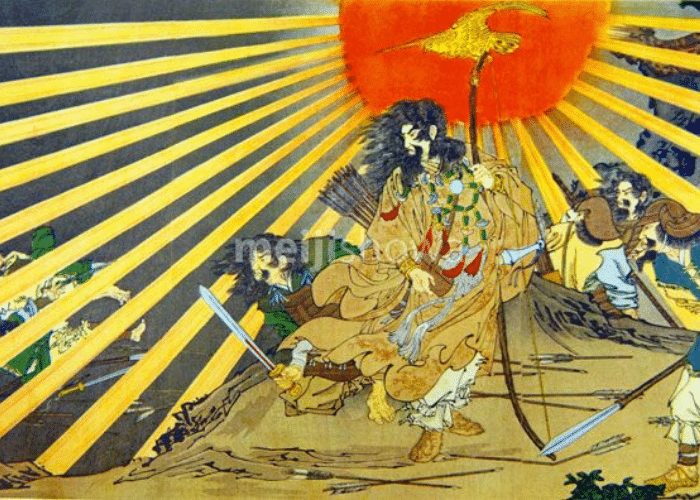
Japanese
Who is the Great God Ninigi in Japanese Mythology?
Who is the Great God Ninigi in Japanese Mythology?
Ninigi is called the Great God in Japanese legends, but what made him so important?
According to legend, Ninigi-no-Mikoto was the grandson of the sun goddess Amaterasu and the agricultural god Takamimusubi.
He was sent to earth as the first of the heavenly gods to rule there. He took the kami of the cherry blossoms as his wife and gave the first rice to his people.
Ninigi’s importance in Japan, however, lasted long past his own death.
Ninigi’s great-grandson, Jimmu, was said to have been born in the late 8th century BC. In 660 BC he took the throne as Emperor Jimmu.
The Imperial family of Japan still claims descent from this legendary emperor. This claim has helped to establish them as the longest-lasting hereditary monarchy in the world.
Ninigi-no-Mikoto and the Beginnings of Japan
The deity Ninigi went by many names. One of the most common was Ninigi-no-Mikoto, the Great God Ninigi.
He was the son of Oshihomimi, who was the first child created by the sun goddess Amaterasu.
Ninigi was was well-loved by the other gods. His grandfather Takamimusubi, the god of agriculture, was particularly fond of him.
There are many versions of the story of how Ninigi was sent to land.
Some stories claimed that he was the first god selected for the task based on his standing. Others say that his father was offered rule of the Earth first and declined.
In another version of the story, the Earth had already been settled by one group of gods. Okuninushi, however, was an unpopular ruler whose land had become chaotic, so the other gods had demanded that he be removed and replaced with the more capable Ninigi.
Takamimusubi sent warriors to drive the evil kami from the land in preparation for Ninigi’s rule. He then gave his grandson three wondrous gifts.
Kusanagi was a perfectly-made sword that could control the winds and kill any monster. It represented the virtue of valor.
Yata no Kagami represented the truth and wisdom. It was an octagonal mirror.
Yasakani no Magatama was the jewel of benevolence. It was the first magatama, curved stone or jade beads which were used for ceremonial purposes from at least the 10th century BC.
In many versions of Ninigi’s story he was also given a gift from his grandmother. Amaterasu give him an ear of rice so he could feed the people of his new world.
When Ninigi first tried to go to Earth he was blocked by Sarutahiko. Uzume, the goddess of the dawn, persuaded the lord of the terrestrial kami to let Ninigi and his retinue pass to take their place on Earth.
Ninigi descended on Mount Takachiho and built his palace there. He was a wise and just ruler, but his time on Earth was not entirely happy.
According to legend, Ninigi spotted Konohanasakuya, also called Sakuya-hime, the kami of the cherry blossoms. He fell instantly in love with her and went to her father, the mountain kami Oho-yama, to ask for her hand in marriage.
Oho-yama had an older daughter who he wished to see married first, however. Iwo-Naga was the kami of stone who was heartier than her younger sister but nowhere near as lovely.
Ninigi refused to marry Iwo-Naga and made Sakuya-hime his wife. Her cherry blossoms became a symbol of Japan.
Cherry blossoms are short-lived, however. For choosing the fleeting beauty of the flowers over the lasting strength of stone, Ninigi and his descendants were cursed to have their own lives shortened.
Ninigi and his new bride lived long enough to have three sons, however.
Their son Hoori was a hunter. His son’s wife Tamayori-hime gave birth to a son named Jimmu, in the year 711 BC according to written legends, who became the first Emperor of Japan.
My Modern Interpretation
The first verifiable Japanese emperor was Kinmei, who lived roughly a hundred years after Jimmu supposedly established the position. The Imperial family, however, still claims descent from the Amaterasu through the legendary first emperor.
The claim of divinity was used in many ancient societies to justify the right to rulership.
In Rome, for example, each of the patrician families claimed descent from a god or goddess of Olympus. The city itself, they said, was established by children of the gods.
The Greeks, too, claimed divine kinship. Virtually every city and colony in the Greek world claimed that it was founded by and first ruled by the child or grandchild of a god.
Some rulers were considered to be the gods in mortal form rather than their descendants. The Egyptian pharaohs, Hawaiian akua ali’i, and Sapa Inca rulers of South America all considered themselves to be incarnations of the gods.
This type of link to the divine was a way of legitimizing rule. The kings and nobles who claimed such a link could say that descent from the gods, even after many generations, made them naturally more fit for leadership than common men.
This not only made the king’s decisions divinely inspired but also helped to prevent attempted coups or assassinations. This divine continuity is nowhere more apparent than in the imperial line of Japan.
The current Emperor of Japan, Naruhito is said to be the 126th ruler of the Yamato Dynasty, which has supposedly been in place since Emperor Jimmu claimed power in 660 BC.
Historically, the Yamato Dynasty’s hold on power is only slightly less impressive. Historical records confirm that the family has provided all of Japan’s emperors for at least 1,500 years.
Unlike many other rulers around the world, the Japanese emperors have not traditionally been military leaders or had significant influence over the law. Their position as conduits between the country and its gods have helped to secure their position.
At various points in the dynasty’s long history its rulers have been virtual puppets of other families or factions. Their ancient link to the gods, however, has kept them in place as figureheads.
Since the end of World War II, the emperors of Japan have rejected claims of divinity, although they are still the titular heads of the Shinto religion. They serve as symbols of the country and its history but under the modern constitution play no role in government and are no longer believed to be gods on Earth.
They do, however, still claim to have a link to Emperor Jimmu’s legendary ancestors.
The sword, jewel, and mirror given to Ninigi are still considered to be the official Imperial Regalia of Japan. They are said to be housed under carefully controlled conditions and close guard at various shrines around the country.
The existence of these relics is impossible to confirm, however. Because they are considered divine they are never put out for public viewing and are kept covered even when used in ritual purposes.
Stories have existed for hundreds of years that one or more of Ninigi’s great gifts have been lost. Kusanagi, the sword, is often said to be a replica of the original after it was lost over 1,000 years ago.
Symbolically, however, the relics of Ninigi are still important. Like the emperors themselves they are still considered to be a symbolic link to Japan’s prehistoric past even if they are no longer considered divine.
In Summary
Ninigi was the grandson of Amaterasu, the sun goddess, and Takamimusubi, the god of agriculture.
He was well-liked among the gods and was thus chosen to be the ruler of Earth. To symbolize his rule and virtues he was given a sword, mirror, and jewel.
He was also given the first rice to feed his subjects. He married Sakuya-hime whose cherry blossoms also became a symbol of his new land, although her brief lifespan also meant he and his descendants would have shortened lives.
Ninigi’s great-grandson took power in 660 BC and was, according to legend, the first emperor of the Yamato Dynasty.
The Yamato Dynasty, which can historically be traced to about 1,000 years after Jimmu’s supposed accession, continues to this day. Although modern emperors have rejected claims of divinity and serve only as figureheads, they and their legendary regalia still provide a link to their country’s ancient past.


